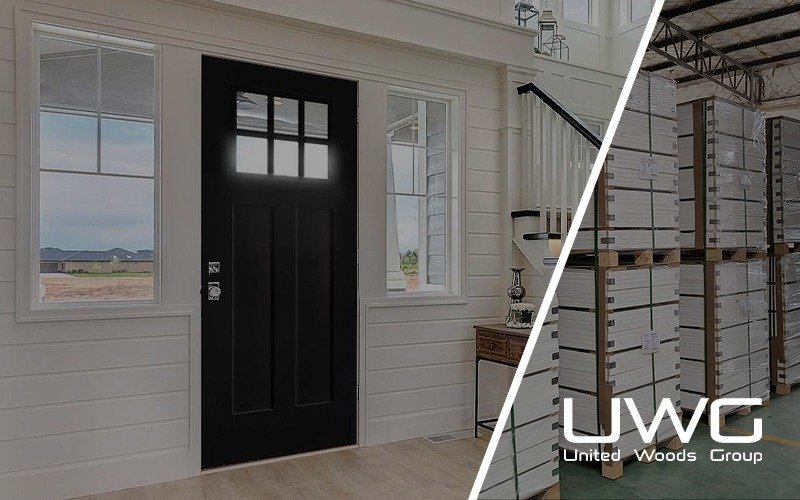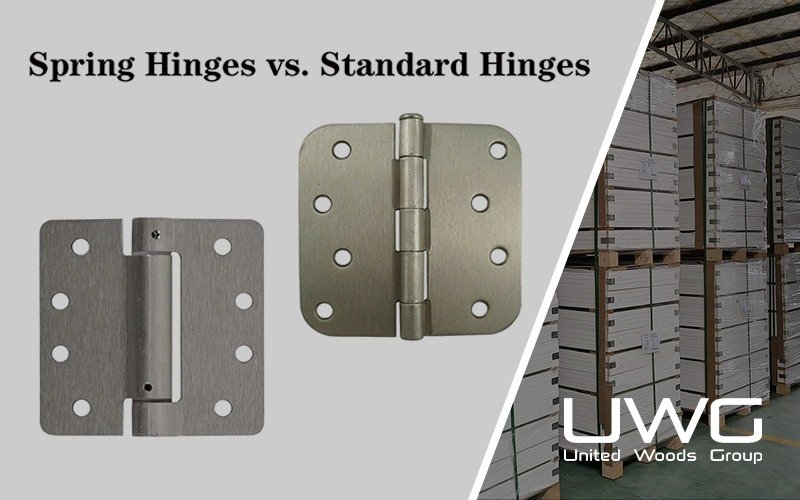Imagine you’re on a construction site, mid-project, and the client suddenly asks, “Will this door last through extreme weather?” You glance at the specs. It’s fiberglass—but what does that really mean? Builders and wholesalers alike need materials that balance durability, performance, and cost.
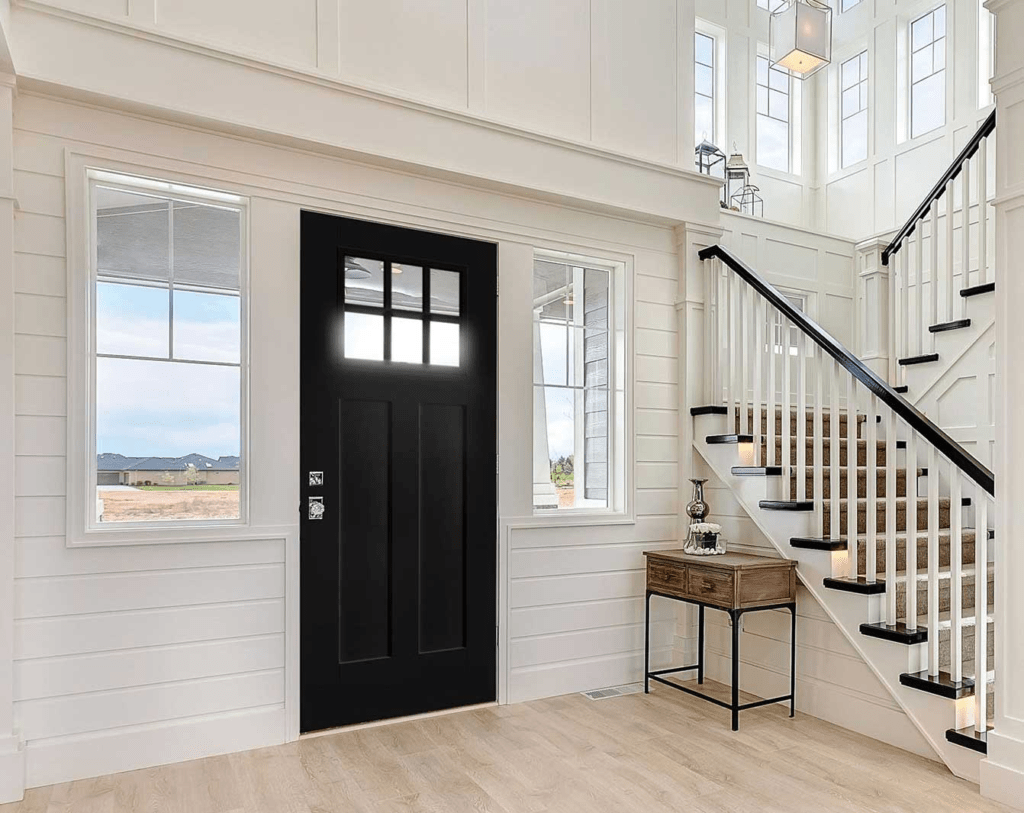
1. Definition of a Fiberglass Door
A fiberglass door is a type of engineered door system that uses fiberglass-reinforced plastic (FRP) as the outer surface. Unlike traditional wood or steel doors, it is a composite construction that combines multiple materials to achieve strength, durability, and long-term performance.
A typical fiberglass door is composed of three main elements:
- Fiberglass Skins Molded sheets form the visible exterior. They can be smooth for a sleek, modern look or embossed with realistic wood-grain textures to replicate oak, mahogany, or other popular species.
- Structural Stiles and Rails Usually made of composite materials or laminated veneer lumber (LVL). These provide dimensional stability, support hardware installation, and prevent edge warping.
- Core Materials High-density polyurethane foam or engineered wood composites are commonly used. These improve thermal insulation, reduce overall weight, and enhance impact resistance.
Because fiberglass is non-porous and dimensionally stable, doors made from it do not swell, crack, or rot in humid conditions. At the same time, they avoid denting and rusting issues often found in steel doors.
For builders and wholesalers, a fiberglass door should not be viewed simply as a substitute for wood. Instead, it is a specialized product engineered to balance aesthetics, energy efficiency, and lifecycle value, making it a versatile solution for both residential and commercial applications.
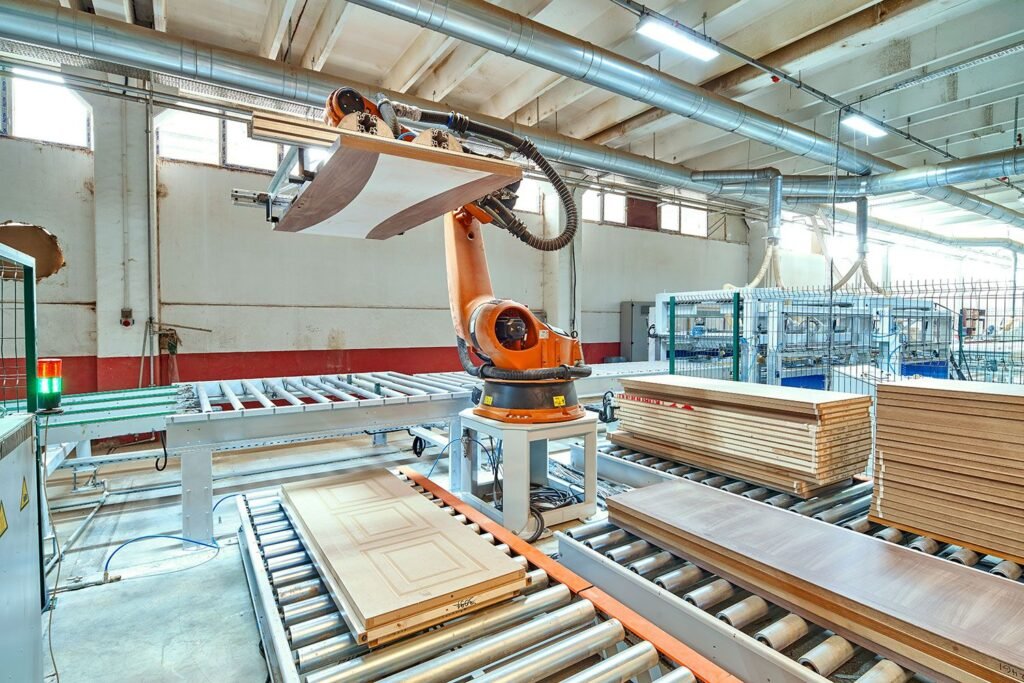
2.What are the pros and cons of fiberglass doors?
Pros of Fiberglass Doors
1. Excellent Durability
Fiberglass doors are highly resistant to warping, rusting, denting, and rotting. Unlike wood or steel, they hold up exceptionally well in areas with moisture, extreme temperatures, or heavy use. This durability makes them ideal for exterior applications across different climate zones.
2. Low Maintenance Fiberglass requires minimal upkeep compared to wood. Most models come prefinished with factory-applied coatings that last for years. There’s no need for regular painting or sealing, which saves labor and material costs over the door’s lifespan.
3. Energy Efficiency Many fiberglass doors are insulated with polyurethane foam cores, providing excellent thermal performance. This helps in maintaining interior temperatures, reducing HVAC load, and improving overall energy efficiency for both residential and commercial buildings.
4. Wood-like Appearance Modern fiberglass doors can replicate the look of real wood with high-definition grain patterns and stainable finishes. They offer the visual appeal of wood without the downsides, making them popular for both contemporary and traditional architectural styles.
5. Wide Range of Styles and Sizes Fiberglass doors are available in numerous designs, panel configurations, and glazing options. Manufacturers offer a broad selection of standard sizes, and some also provide custom design services—ideal for projects that require aesthetic flexibility.
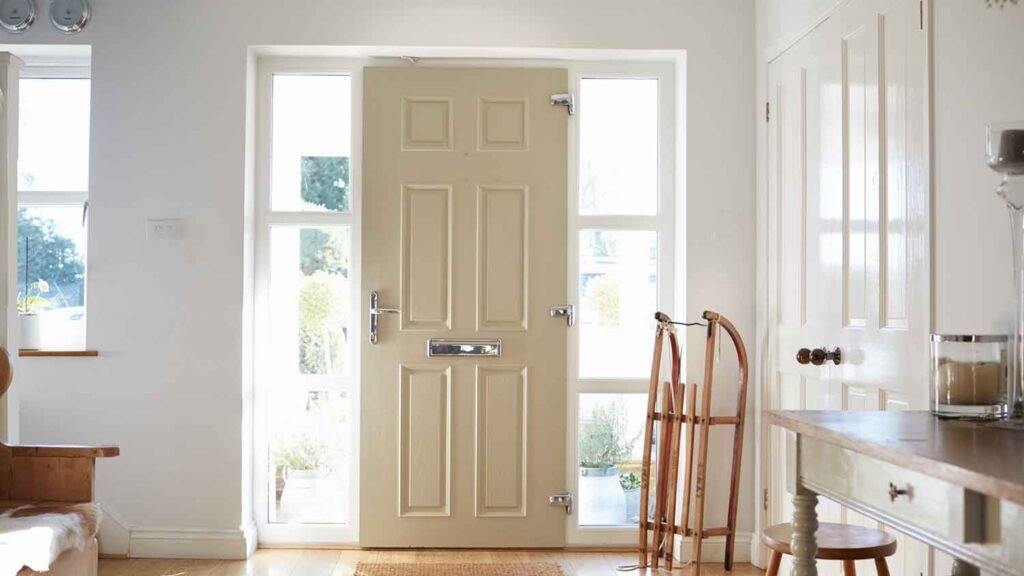
Cons of Fiberglass Doors
1. Higher Upfront Cost (Especially for Custom Orders) While standard fiberglass models are competitively priced, customized doors—non-standard sizes, unique finishes, or special glazing—can be significantly more expensive. This may affect the budget in projects with tight cost constraints.
2. Cracking Risk Under Heavy Impact Though durable in everyday conditions, fiberglass can crack or fracture if hit with strong force, particularly at weak points like corners or edges. Damages during transport or jobsite handling may require full replacement.
3. Difficult to Modify or Repair Once damaged, fiberglass doors are harder to repair than wood. Deep scratches or cracks often need professional service, specialized materials, and exact color-matching. On-site modifications (e.g., resizing or cutting) are also limited due to the molded structure.
4. Limited Flexibility for Certain Hardware Installations The foam core and composite skin make it difficult to install aftermarket or heavy-duty hardware without special reinforcement. Builders may need to plan hardware placement in advance or use specific mounting solutions approved by the door manufacturer.
3. Are fiberglass doors better than wood?
1. Durability in Real-World Conditions
Fiberglass doors are specifically engineered to withstand harsh environmental conditions. Unlike wood, which expands, contracts, and eventually degrades when exposed to moisture, fiberglass remains dimensionally stable. This is especially important for exterior doors that face seasonal temperature swings, humidity, rainfall, or even salt air in coastal environments. Fiberglass doesn’t warp, rot, or split, and it resists dents and scratches from daily wear. For builders working on large residential developments or high-traffic commercial entrances, this translates to fewer replacements and warranty claims over time. Additionally, fiberglass doors are impervious to insects such as termites, a common issue with wooden doors in warm climates.
2. Maintenance Requirements
One of the biggest advantages of fiberglass over wood is how little maintenance it requires. Wood doors demand constant care: sanding, sealing, repainting, and monitoring for mold or decay. This adds not only cost but also ongoing labor after installation, especially in environments with high UV exposure or precipitation. Fiberglass doors, on the other hand, are often delivered factory-finished with protective coatings that can last a decade or more without fading or peeling. For wholesalers, this makes fiberglass an easy-to-market product with long-term value; and for builders, it’s one less thing to worry about in post-construction support or customer satisfaction.
3. Appearance and Aesthetics
Historically, wood was the preferred choice for high-end aesthetics because of its natural grain and rich texture. However, fiberglass manufacturing has advanced significantly. Today’s fiberglass doors are crafted with high-definition grain patterns that mimic real wood, including oak, mahogany, and cherry finishes. These doors can be stained or painted to match virtually any design scheme, offering nearly the same level of customization as real wood—without the vulnerability. For most homeowners, the difference is indistinguishable unless viewed up close. This allows builders to deliver a premium look at a lower cost and with greater consistency across large-scale projects.
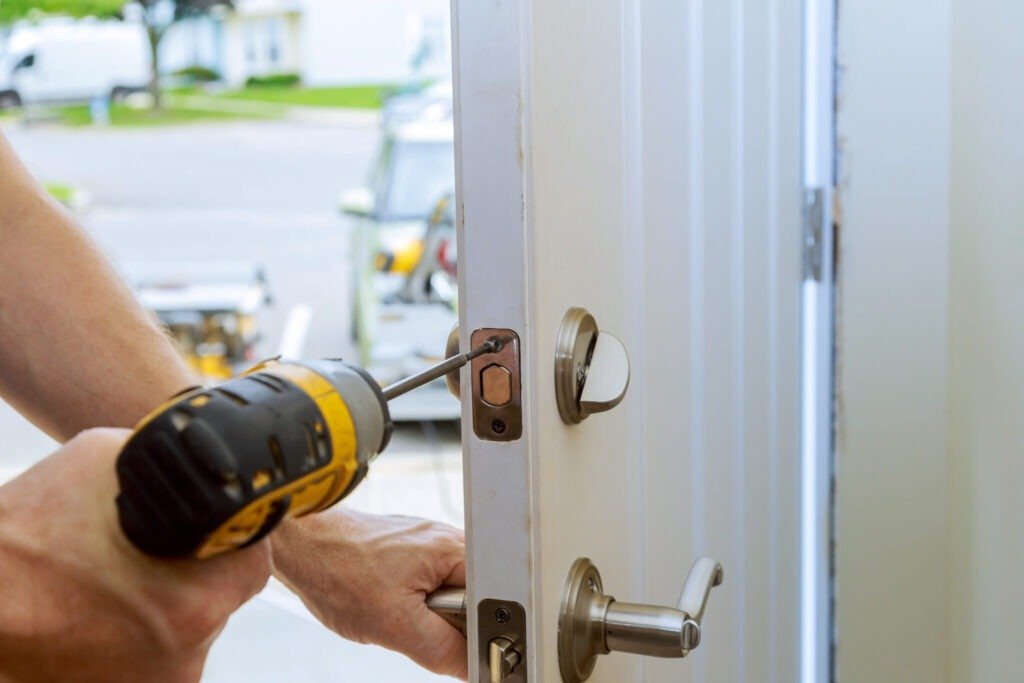
4. Fiberglass door vs wood: which is better for builders?
1. Consistency and Predictability on the Jobsite
For builders managing complex timelines and high production volume, consistency is key. Fiberglass doors are factory-made using precision molds, which ensures uniform sizing, thickness, and surface finish across every unit. This level of control eliminates surprises during installation and simplifies inventory management. In contrast, wood is a natural material—each piece varies slightly in grain, density, and moisture content. Even when sourced from the same supplier, wood doors may expand or contract differently depending on weather and handling, potentially causing issues with alignment or fit after installation.
2. Faster, Cleaner Installation
Fiberglass doors arrive prefinished and ready to install, saving hours of labor typically spent sanding, staining, painting, or sealing wood doors. They are also lighter than solid wood, making them easier to lift, hang, and adjust—especially valuable when crews are installing multiple doors per day. In high-volume residential or multifamily projects, these time savings add up quickly, reducing payroll costs and allowing the project to move faster. On the other hand, wood doors often require finishing on-site, adding variables such as drying time, odor control, or the need for temperature-controlled conditions.
3. Weather Resistance and Site Durability
Construction doesn’t always happen under ideal conditions. Rain, humidity, dust, and fluctuating temperatures are common on active job sites. Fiberglass doors can sit uninstalled for days or weeks without degrading—they don’t absorb moisture, swell, or delaminate. Wood doors, however, are far more sensitive. If they aren’t sealed quickly and properly, they may begin to warp or crack before installation is complete, especially in exterior applications. Builders using fiberglass experience fewer weather-related failures or callbacks after the job is done.
4. Reduced Post-Installation Maintenance and Service Calls
Builders often face complaints weeks or months after a project is handed over—swollen door frames, sticking hinges, or peeling finishes are common with wood. Fiberglass doors, by contrast, hold their shape and appearance over time, even with minimal upkeep. They’re resistant to UV rays, pests, and moisture, which means fewer warranty claims or costly service visits. For builders looking to protect their margins and reputation, fiberglass doors offer long-term peace of mind.
5. Energy Efficiency and Building Code Compliance
Most fiberglass doors feature high-performance foam cores that meet or exceed current energy codes. They help builders achieve better insulation ratings (R-values), which is critical in today’s market where energy efficiency is not just a selling point but a compliance requirement. Wood, while a natural insulator, does not offer the same performance unless combined with added materials—often increasing cost and complexity.
6. Long-Term Cost Advantage
Although the initial purchase price of a fiberglass door may be on par with or slightly higher than a wood door, the overall project cost tells a different story. Fiberglass requires less labor, fewer repairs, and almost zero long-term maintenance. When scaled across dozens or hundreds of units, these savings become significant. Builders also benefit from reduced material waste, as fiberglass doesn’t crack or split as easily during transport and installation.
7. Design Flexibility with Fewer Compromises
Some builders worry that fiberglass limits design choices—but modern products have come a long way. Today’s fiberglass doors feature realistic wood grain textures, decorative glass inserts, and custom panel designs that rival true wood in appearance. For builders working with clients who want the “look” of wood without the hassle, fiberglass offers the best of both worlds. Customization is possible, but unlike wood, it doesn’t come at the cost of structural integrity or performance.
Conclusion: Which Is Better for Builders?
In most cases—especially for builders focused on timelines, labor control, and risk management—fiberglass is the superior choice. It offers reliable performance, reduces jobsite unpredictability, and supports faster project completion with fewer complications. Unless a project specifically demands the aesthetics or custom craftsmanship of wood, fiberglass doors are the more practical, builder-friendly solution.

Summary
Back on the job site, when a client asks, “Will this door hold up over time?”, the answer becomes clear: fiberglass doors check all the right boxes. They’re tough enough to handle real-world conditions, efficient to install, and built to last without constant upkeep. For builders managing timelines and wholesalers supplying quality at scale, fiberglass isn’t just an alternative—it’s a strategic advantage. Wood may win in niche scenarios, but when consistency, durability, and efficiency matter most, fiberglass leads the way.

